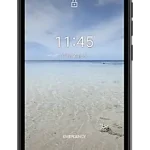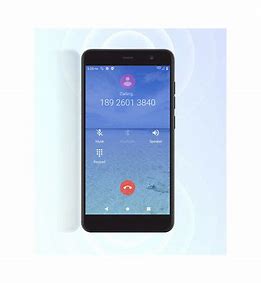

When you’re up and running, explore what your phone can do.
| Topic | Location |
| Find these fast: Wi-Fi, airplane mode, flashlight, and more. | Quick settings |
| Choose new wallpaper, set ringtones, and add widgets. | Customize your phone |
| Experience crisp, clear photos, movies, and videos. | Camera |
| Browse, shop, and download apps. | Apps |
| Keep your info safe. Set up your password and more. | Protect your phone |
| Ask questions, get answers. | Speak |
| Share your Internet connection. | Wi-Fi hotspot |
This product meets the applicable national or international RF exposure guidance (SAR guideline) when used normally against your head or, when worn or carried, at a distance of 5 mm from the body. The SAR guideline includes a considerable safety margin designed to assure the safety of all persons, regardless of age and health.
Caution: Before using your phone, please read the Legal information. Swipe up from bottom > Settings > About phone > Legal information.
Get Started
First look
Let’s get started. We’ll guide you through startup and tell you a bit about your phone’s features.
Note: Certain apps and features may not be available in all countries.
Power button
Your Power button helps in a few ways.
- Power on/off: Press and hold the Power button, then tap Power off. When your phone is off, press and hold the Power button to turn it on.
- Sleep: To conserve battery power or prevent accidental touches, put the touchscreen to sleep by pressing the Power button.
- Wake up: Press the Power button again.
- Reboot: To reboot your phone, press and hold the Power button, then tap Restart.
Tip: To add security to your phone, see Protect your phone.
Volume buttons
Your volume buttons can help:
- Ringer volume: Press the buttons when your phone is ringing to silence it.
- Earpiece volume: Press the buttons during a call.
- Music/video volume: Press the buttons during a song or video.
Tip: For more on volume control, see Volume
Insert the SIM and microSD cards
To activate phone service, you might need to insert a SIM card, or this may have been done for you. You can also add a microSD card, which is optional and sold separately.
Remove the back cover
To insert SIM and memory cards, remove the back cover.
Caution: Don’t use tools to remove the cover—doing so may damage your phone.
Put in the cards
Caution: Make sure you use the correct size SIM card and don’t cut the SIM card.
Note: If you need to remove the SIM card, follow the instructions below.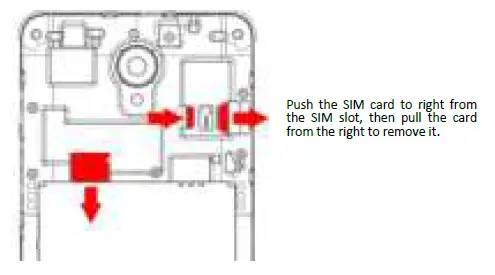
Charge up and power on
Put on the back cover. Charge your phone fully and turn the power on. Follow the screen prompts to get started.
Sign in
If you use Gmail™, you already have a Google™ account—if not, you can create an account during setup. Signing into your Google account lets you access, sync, and backup your stuff. You can see your Google apps, contacts, calendar, photos, and more. Tips
Tips
- To add, edit, or delete accounts, swipe up from bottom > Settings > Accounts.
- To set up email accounts, see Gmail.
- For help with your Google account, visit www.google.com/accounts. Connect to Wi-Fi
For faster Internet access and to conserve data use, swipe the status bar down twice, then tap to connect to Wi-Fi. For full instructions, see Connect with Wi-Fi.
Note: This phone supports apps and services that may use a lot of data, so make sure your data plan meets your needs. Contact your service provider for details.
Explore by touch
Find your way around:
Tap: Choose an icon or option.
- Touch and hold: See more options. Drag: Move items on the home screen.
- Swipe: Scroll through lists or between screens.
- Pinch or double-tap: Zoom in and out on websites, photos, and maps.
- Twist: Twist a map with two fingers to rotate it, and pull two fingers down to tilt it.
- Back: Tap Back to go to the previous screen.
- Home: Tap Home to return to the home screen.
- Recents: Tap Recents to see your recent apps (or browser tabs), and tap an app app from the recent list, swipe it up, to remove all apps from the recent list, swipe right and tap CLEAR ALL. To scroll the list, swipe left or right. Note: You don’t need to remove apps from Recents for your phone to run efficiently.
- Split screen: From the recent apps list, touch and hold an app and then tap Split screen, the app will turn to the top of the screen to view two apps at once. Not all apps will work in split screen. To close the split screen, drag the dividing line to the bottom of the screen. Menus: When you see you can tap it to open options for the current screen.
- Close Keyboard: To close a keyboard, Tap Back
Improve battery life
Your phone processes tons of information. Depending on what you use, that can take a lot of power.
When your phone is stationary, not charging, or not in use for a period of time, unnecessary background processes are shut down to optimize battery life.
- To see what’s using up battery power, swipe up from bottom >Settings > Battery ,tap menu > Battery usage.
- To help improve battery life, swipe up from bottom > Settings > Battery > Battery saver, and turn it on.
Tip: To quickly open Settings, swipe down on the status bar and tap
Battery Tips
To save even more battery life between charges, you could reduce:
- Widgets that stream information to your home screen, like news or weather.
- Unused accounts: Swipe up from bottom > Settings > Accounts.
- Recording or streaming videos or music.
Learn the basics
Home screen
The home screen is what you see when you turn on your phone. From here you can explore apps and more.
Note: Software updates happen frequently, so your screen may look a little different.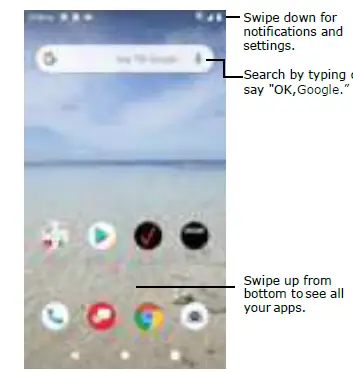 Tips
Tips
- Open app list: Swipe up from bottom to see all your apps.
- Return home: To return to the home screen from any location, tap
- Pages: To add a page, drag an app to the right side of the screen until you see a new page. You can add multiple pages. To see other pages of shortcuts and widgets (if available), swipe the home screen left.
- Settings: To quickly open common settings, swipe the status bar down. To open more settings, tap.
- Customization: To personalize your home screen, see Customize your phone.
Search
On the home screen, tap the Google Search box for a text search or tap to search by voice.
When you type, suggestions appear below the search field:
- To search for a suggestion, tap it.
- To search for text in the search field, tap on the keyboard.
Tip: To close the keyboard, tap
Note: For more on voice search, see Speak.
Notifications
At the top of the screen, icons on the left notify you about new messages or events. If you don’t know what the icon means, swipe the status bar down for details.
Tip: Getting too many notifications? Touch and hold a notification to see which app is sending them to you. Then you can turn them off.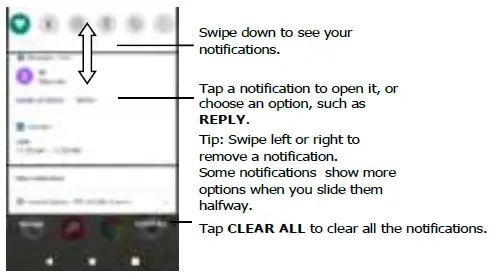 Tip: To quickly change common settings, swipe the status bar down. For more, see Quick settings.
Tip: To quickly change common settings, swipe the status bar down. For more, see Quick settings.
App notifications
You may see a notification dot on an app. This app notification, or badge, tells you the app has an update or an announcement, such as a new email or a missed call. Press and hold the app for more information, options, or app shortcuts.
Wireless Emergency Alerts (U.S. and some countries)
Wireless Emergency Alerts, also known as CMAS or PLAN, is a U.S. national emergency alert system. Emergency alerts can pop up to tell you about a national or local crisis. After you close an alert, you can reopen it by swiping up from bottom > Settings > Apps & notifications > Advanced > Emergency alerts. 
Tip: Emergency alerts have a special sound and vibration that is two seconds long, followed by one second, then another one second.
To choose which types of alerts you receive, swiping up from bottom > Settings > Apps & notifications > Advanced > Emergency alerts. The U.S. and local governments send these alerts through your service provider. So you will always receive alerts for the area where you are, and you won’t receive alerts if you’re outside of the U.S.
For more, visit www.ctia.org and search “wireless emergency alerts.”
Status icons
Icons at the top right of the screen tell you about phone status:
| Status Icons | |
| Network strength | Do not disturb |
| Wi-Fi in range/connected | Alarm set |
| Bluetooth earphone connected | Data Saver on |
| Airplane mode | Battery Saver |
Volume
Press the side volume buttons up or down to select a ringer volume from high to silence, tap access to sound interface that show all volume controls.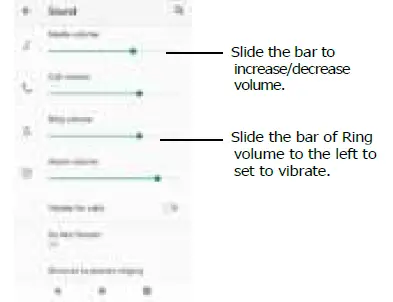
Do not disturb
To turn off some or all sounds, swipe the status bar down with two fingers, and tap Do not disturb. Then tap the switch to turn it on, mute device but allow exceptions, select one of these options:
- Calls: Allow from starred contacts and repeat callers. Tap Allow calls, select From anyone, From contacts only, From starred contacts only or Don’t allow any calls as you need.
To create an exception for repeat callers that allows a call from the same person within a 15 minute period, tap Allow repeat callers to turn it on. - SMS, MMS, and messaging apps: Tap Allow messages to select From anyone, From contacts only, From starred contacts only or Don’t allow any messages as you need.
- See all exceptions: Tap See all exceptions to select the options as you need, when Do Not Disturb is on, sound and vibration will be muted, except for the items you allow above.
- Restrict notifications: Select No sound from notifications, No visuals or sound from noti fications or choose indefinitely as you need. Tap Custom to Custom restrictions.
- Default duration: Select Until you turn off, Ask every time or customize how long you want to only hear priority interruptions.
- Schedules: Set the schedules as you need.
Lock Screen
Your touchscreen is on when you need it and off when you don’t.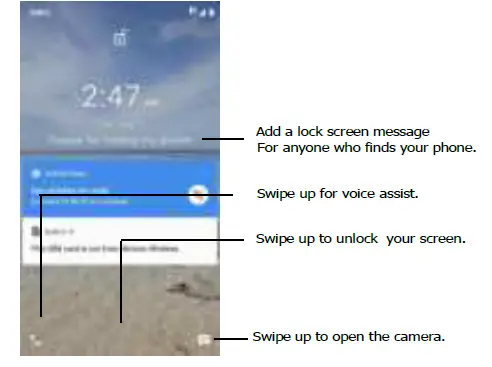
- Screen off and on: Press the Power button to turn the screen off and on.
- Screen lock: To unlock the screen, swipe up from bottom of the locked screen. To apply security to the lock screen (recommended), see Screen lock.
- Notifications: Double tap a notification in the lock screen to open it.
Tip: To prevent notifications from appearing in the lock screen, swipe up from bottom > Settings > Apps & notifications > Notifications > Notifications on lockscreen > Don’t show notifications. - Owner info: To add a message to your lock screen, swipe up from bottom > Settings > Display > Advanced > Lock screen display > Lock screen message.
- Screen timeout: To change your timeout (screen locks automatically), swipe up from bottom > Settings > Display > Advanced > Screen timeout.
Quick settings
For quick access to Wi-Fi, Bluetooth, Airplane mode, brightness, and other settings, swipe the status bar or lock screen down. For even more settings, tap . Tap to rearrange your settings and add or remove settings. 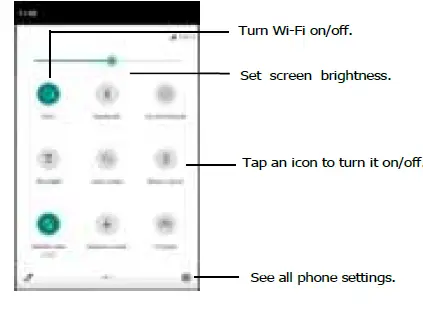
Speak
Google Voice™
Use Google voice commands to tell your phone what you want.
Use voice to make a call: Tap on the home screen or say “Ok Google” to control your phone by voice.
The say “Call” and then a contact name or number. Or,say “Sent text,” “Go to” an app, or “Help”.
Voice to text
On a keyboard, tap , then speak your message or search text. You can also speak punctuation.
Google Assistant™
Note: This feature may not be available in all languages.
Ask your phone questions, find answers and set tasks using the Google Assistant. To turn on the Google Assistant, swipe up from bottom > Settings > Google > Account services > Search, Assistant & Voice > Google Assistant.
Touch and hold Home from any screen, then speak or type a command. You can also say, “Ok Google” to open the Google Assistant.
Screen search
Note: This feature may not be available in all languages.
Screen search provides information based on the app you’re in. Touch and hold Home while in an app.
To turn Screen search on/off, swipe up from bottom > Settings > Google >
Account services > Search, Assistant & Voice > Google Assistant > Assistant > Phone > Use Screen context.
For more on the Google Assistant, visit https://support.google.com/assistant.
Direct Share
In some apps, you can share something directly to an app or conversation. Select the share option within an app, then choose an app to share.
Picture-in-Picture
If you’re watching a video, on a video call, or using navigation, and you change screens, your video continues to play in a small window on your screen.
- Tap the small window to enlarge it, then tap it again to return to it.
- Tap the small window to enlarge it, then tap the to close it.
- Tap Home to put video in small window.
- Drag video around your screen.
Note: Not all apps support this feature.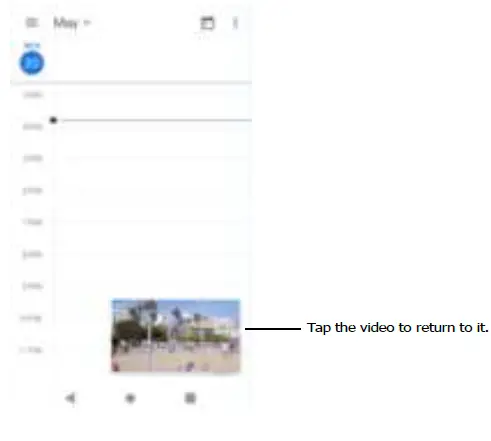
Customize your phone
Redecorate your home screen
Customize your home screen the way you want.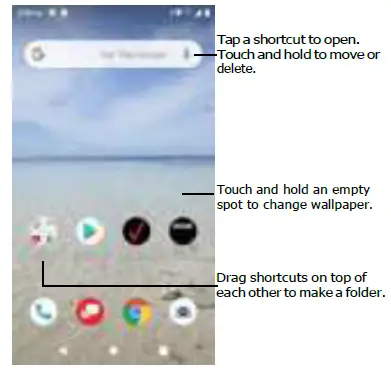
- Change your wallpaper: Touch and hold an empty spot on the home screen, then tap WALLPAPERS.
- Add a home screen page: Drag an app to the right side of the home screen until a new page appears. You can add multiple pages.
- Adjust display settings: Adjust brightness, font size, and screen saver. Swipe up from bottom > Settings >Display.
- Rotate: In many apps, the touchscreen switches from portrait to landscape when you rotate your phone. To turn this on or off, swipe up from bottom > Settings > Display > Advanced > Auto-rotate screen.
Choose apps and widgets
- Add apps to the home screen: Swipe up from bottom, touch and hold an app, then drag it to one of your home screen pages.
- Download new apps: Tap Play Store. For more on apps, see App safety.
- Group apps together: Drag one app onto another. Do it again to add more apps to the folder. To name the folder, tap it and enter a name below the apps.
- See app options: Touch and hold an app. If the app has quick options (shortcuts), you’ll see a list.
- Add widgets: Touch and hold an empty spot on the home screen, tap Widgets, touch and hold a widget, then drag it to your home screen.
- Resize widgets: You can resize some widgets—touch and hold a widget until you see several white circles at the edges, then release. Drag the white circles to resize.
- Move or delete widgets and apps: Touch and hold a widget or app and drag it to another spot, another page, or to Remove.
Note: Removing an app from your home screen doesn’t uninstall the app from your phone.
Customize sounds and appearance
Customize your phone’s sounds and display settings:
- Set ringtone and notifications: Swipe up from bottom> Settings > Sound.
Tip: Set notification sounds for individual apps within the app’s settings. - Add vibrate for calls: To make your phone vibrate, swipe up from bottom > Settings > Sound and tap Vibrate for calls. To silence incoming calls, see Do not disturb.
- Set ringtone for a contact: Swipe up from bottom > Contacts, tap the contact, then tap Menu > Set ringtone.
- Change language: Swipe up from bottom > Settings > System > Languages & input > Languages.
- Adjust font size: Swipe up from bottom > Settings > Display > Advanced > Font size
Apps
Your phone comes ready with some great apps. To find and add more apps, tap Play Store. To learn more, see App safety.
Phone
Keep in touch by choosing a contact, returning a missed call, or using a voice command to start a call.
Make a call
Find it: Phone
- Call a contact: To call a contact or recent call, tap next to the caller’s name or number.
- Dial a phone number: To open the dialpad, tap . Enter a number, then tap to call it.
- Voice dial: To voice dial, tap on the home screen or say “Ok Google”, then say “Call <name>”.
- Voicemail: appears in the status bar when you have new voicemail. To hear it, swipe down and tap the notification. Or swipe up from bottom > Phone > Voicemail, select a voicemail then tap to play the voicemail. If inbox is full, user needs to delete voicemails to receive new voicemail.
- Answer a second call: To answer a second call, tap Hold and Answer Voice. The first call is placed on hold. To switch between calls, tap Swap.
- Make a contact widget: Touch and hold an empty spot on the home screen, tap Widgets, then touch and hold the Direct dial widget. Drag it to your home screen, then select the contact. Tap the widget to call the person.
Tip: To enter the international dialing code (+), touch and hold 0. To add 2-sec pause or Add wait after numbers, tap Menu .
During a call - Mute a call: Tap Mute on the call screen to mute the call. You can hear your caller, but they can’t hear you.
- Multi-task: While you’re on a call, tap Home to hide the call screen and look up a phone number, address, or open other apps. To reopen the call screen, swipe the status bar down and tap Ongoing call.
- 3-way call: To join two calls together, answer the second incoming call while your first call is active, or tap Add call to dial a second call. The first call is placed on hold. Tap Merge to join the calls together.
- End a call: Tap .
Receive a call - Answer a call: When your phone is locked, swipe up to answer. When the phone is unlocked, tap ANSWER.
- Ignore a call: When your phone is locked, swipe up to reject the call. When the phone is unlocked, tap DECLINE.
Tip: You can also press the Power button to ignore the call, or press a volume button to silence the ringer. - Respond with a text: When your phone is locked, swipe up , and select a message to respond.
Note: When you hold your phone to your ear, the touchscreen goes dark to avoid accidental touches. When you move the phone away from your ear, the screen lights up again. Don’t use covers or screen protectors (even clear ones) that cover the proximity sensor above the touchscreen.
Your phone number
Find it: Swipe up from bottom > Settings > About phone > Phone number
Favorites
See all your favorite contacts together.
Find it: Phone >
To add favorites, tap , scroll or search to find the contact, then tap the picture (or letter, if no picture) and tap .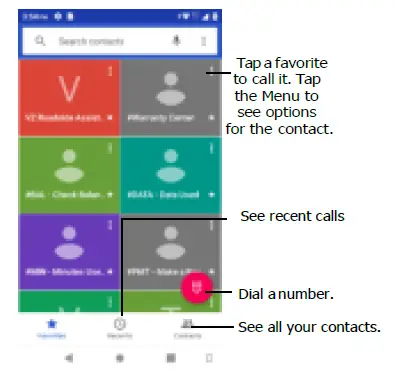
Recent calls
View your calls (with newest first), and then call, text, or store them:
Find it: Phone >
- To return a call, tap next to the caller’s name or number.
- To send a text message, store the number, or other options, tap the caller’s picture.
- To remove an entry from the call log, tap the name or number, then tap Call details > .
- To clear the list, tap Menu > Call history > Menu > Clear call history.
Emergency calls
Your service provider programs one or more emergency phone numbers you can call under any circumstances, even when your phone is locked. Emergency numbers vary by country. Your pre-programmed emergency number(s) may not work in all locations, and sometimes an emergency call cannot be placed due to network, environmental, or interference issues.
- Tap Phone (if your phone is locked, swipe up from bottom to unlock it, then tap Emergency).
- Enter the emergency number.
- Tap to call the emergency number.
Note: Your phone can use location based services (GPS and AGPS) to help emergency services find you. For more information, swipe up from bottom > Settings > Location > Advanced.
Real Time Text
Find it: Phone > Menu > Settings > Accessibility > Real-time text (RTT) call
Tap the Real-time text (RTT) call to turn it on / off. When RTT is on, the user can make a call with real-time text, and RTT icon will be shown in icons area.
- Make a RTT call: To open the dialpad, tap . Enter a number, then tap to call it.
- Receive a RTT call: When your phone is locked, you can swipe up to answer. swipe up to reject the call . swipe up and select a message to respond.

- During an RTT call: In the in-call UI for RTT, tap menu , there are options for you to control the state of the voice call. Tap Mute to mute the call, you can hear your caller, but they can’t hear you. Tap Speaker to make speaker on and off. Tap Keypad to open the dialpad or tap Add call to dial a second call.

- Call history of RTT: In the “Call details” screen, a snippet of the RTT conversation history is displayed. There is a RTT icon to indicate an RTT call.
Messages
Stay in touch with messages and pictures. For tips on using the keyboard, see Use the keyboard.
Find it: Messages
- Create: Tap . .
- Attach: When you’re typing a message, tap to attach file(a picture, audio, video, or more).
- Send: Tap to send the message.
- Reply: Open a conversation, then enter your response in the text box at the bottom and tap .
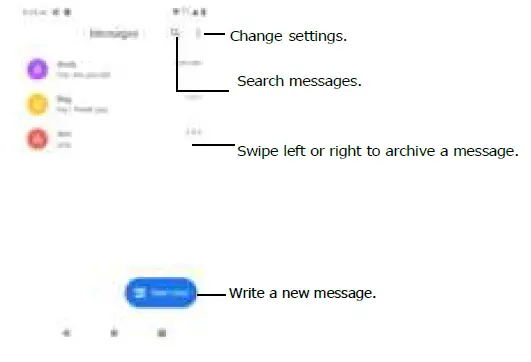
Tips
- Add a contact: In a conversation, touch and hold a message for more options, such as adding to contacts.
- Delete thread: To delete a whole thread of messages, touch and hold the thread, then tap to delete.
- Save pictures: Touch and hold a picture, and then tap to save it. To see the picture, swipe up from bottom > Photos.
- Voice entry: Tap a text box, then tap on the keyboard.
Tip: If you don’t see on the keyboard, swipe up from bottom > Settings > System > Languages & input > Virtual keyboard > Google voice typing to activate voice entry. - Turn off notifications: Stuck in a busy conversation? You can turn off notifications.
Tap the thread, then tap Menu > Settings > Notifications.
Set your default messaging app
To set Messages as your default messaging app, swipe up from bottom > Settings > Apps & notifications > Default apps > SMS app, and select the messaging app to use as the default.
Use the keyboard
When you tap a text box, like in a message or search, you have keyboard options.
- Type or gesture: Enter letters by touching them one at a time. Or, enter a word by tracing a path through the letters. While you’re typing, word suggestions appear above the keyboard. Tap one to select it.
- Voice entry: Tap on the touchscreen keyboard, then say what you want to type.
- Close the keyboard: Tap.
Use the keyboard
When you tap a text box, like in a message or search, you have keyboard options.
- Type or gesture: Enter letters by touching them one at a time. Or, enter a word by tracing a path through the letters. While you’re typing, word suggestions appear above the keyboard. Tap one to select it.
- Voice entry: Tap on the touchscreen keyboard, then say what you want to type.
- Close the keyboard: Tap
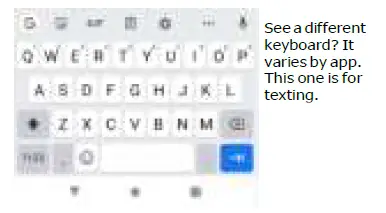
- Symbols and numbers: Touch and hold a letter to enter the number at the top of it.
To enter symbols, tap . - Capital letters: Tap twice quickly.
Tip: Tap for initial capital letters. - Keyboard options: To customize your keyboard, swipe up from bottom > Settings >
System > Languages & input > Virtual keyboard > Gboard. - Cut, copy and paste: Touch and hold a word to highlight it, tap Cut or Copy. Touch and hold the location you want to paste the text, and tap Paste.
Chrome™
Access the Internet with the Chrome browser app.
Find it: Chrome
Or, from the home screen, tap the Google search box and enter or speak text to search.
Note: Your phone uses your Wi-Fi network (or your mobile phone network if no Wi-Fi network is connected) to access the Internet. If you can’t connect, contact your service provider. Your service provider may charge to surf the web or download data.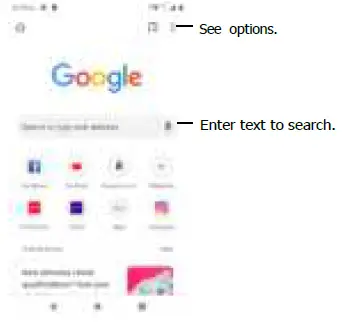
- Go to a web page: Tap the address bar at the top of a page and enter an address.
- Add a bookmark: Tap Menu > .
- Open a bookmark: Open the address bar, then tap Menu > Bookmarks.
- Web page shortcut: To add a web page shortcut to your home screen, go to the web page and tap Menu > Add to Home screen.
- Mobile sites: Some websites automatically show you a “mobile” version of their page—if you want to show the standard computer versions of all websites, tap Menu > Desktop site.
- Reload: If a page doesn’t load correctly, tap Menu > .
- Tabs: To open a new tab, tap Menu > New tab. To move from one tab to another, tap .
- Clear history: In the browser, tap Menu > Settings > Privacy > Clear browsing data.
Then choose Browsing history, Cached images and files, Cookies and site data, and other options. - Help: For more about Google Chrome, tap Menu > Help & feedback or visit https://support.google.com/chrome.
Downloads
Warning: Apps downloaded from the web can be from unknown sources. To protect your phone and personal data from theft, download apps only on Google Play™.
- Files: Tap the download link. To show the file or app, swipe up from bottom > Files.
- Pictures: Touch and hold it, then tap Download image. To see the picture, tap
Photos > Download.
Browser settings
To change your browser security settings, text size, and other options, tap Menu > Settings.
Safe surfing & searching
Keep track of what your browser and searches show:
- Incognito: To open a tab that won’t appear in your browser or search history, Menu > New Incognito tab.
- Pop-ups: To stop pop-up windows from opening, tap Menu > Settings > Site settings > Pop-ups and redirects, then tap the switch to turn it off.
Camera
Take crisp, clear photos with the back or front camera.
Take photos
Find it: Camera
- Take a photo: Tap to take a photo.
- Take a selfie: Tap in the camera screen to switch to the front camera.
- Zoom: Drag two fingers apart to zoom in. To zoom out, drag your fingers together. Or, swipe up or down with one finger.
- Multi-shot: Touch and hold to take a burst of photos with the Continuous Shot on.
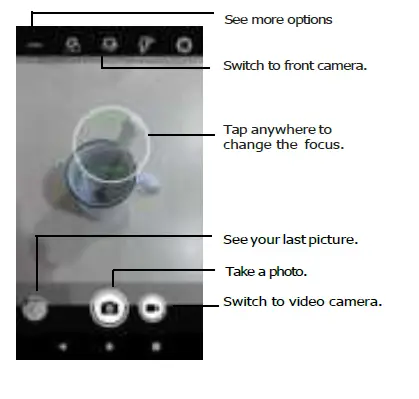
Record videos
Find it: Camera, then tap .
Tap to start recording. Then tap to stop recording.
Camera settings
Point, tap, and you’re done, or play with these camera options. You can find these options along the top of the camera or video screen:
| Options | |
| Filters | Tap it to select the effect you need. |
| Switch camera | Tap it to switch to front / rear camera. |
| Flash | Set to On, Off, or Auto. With the front facing camera, you can also turn the torch on or off. |
| Settings | Tap it to make settings as needed. |
To find these options, tap Menu on the camera screen:
| Options | |
| Automatic | Control camera settings manually. |
| HDR | Turn on HDR (high dynamic range) effect for better pictures in challenging lighting situations, such as outdoors. |
| ProMode | With Pro Mode, you can manually control settings for ISO, Exposure, White Balance, and Focus. You will have easy access to all of these advanced settings. |
To find these options, tap Settings on the camera screen:
| Options | |
| Storage | Choose a storage location for your photos and videos (Phone or SD Card). |
| Countdown timer | Set a timer to 2 seconds, 5 seconds or 10 seconds. |
| Continuous Shot | Turn on to touch and hold to take a burst of photos. |
| Picture size (rear) | Set the photo resolution for the back camera. |
| Picture quality | Set picture quality to low, standard or high. |
| Exposure | Set the exposure as you need. |
| White balance | Auto by default. Set to incandescent, fluorescent, daylight, cloudy as you need. |
| Shutter sound | Turn the shutter sound on or off. |
| Video quality | Set video quality to HD 720p, SD 480p or VGA. |
| Image Stabilization | Turn on to make image stable. |
| Noise Reduction | Set it to reduce noise. |
| Audio Encoder | Set audio encoder to AMRNB,AAc. |
| Video Rotation | Set video rotation to 0,90,180,270. |
| Restore defaults | Camera settings will be restored to default settings. |
Capture your screen
To capture your phone’s screen, press and hold both the Power and the Volume Down buttons at the same time. To see the screen capture, tap Photos > Screenshots.
Photos
View, edit & share Find it: Photos
- Play, share, or delete: Tap a thumbnail to open it, then tap to share, to delete, or Menu for more options.
Tip: To select multiple files, open a folder, touch and hold a photo, then tap others. Or group photos in an album and share the whole album. - Zoom: Open a photo in your gallery, then double-tap or drag two fingers apart or together on the screen.
Tip: Turn your phone sideways for a landscape view. - Wallpaper or contact photo: Open a picture, then tap Menu > Use as > Wallpaper or Contact photo.
- Edit: Open a picture, then tap .
- Slideshow: Tap a picture, then tap Menu > Slideshow. To stop the slideshow, tap the screen. To show the slideshow on a television or other device, see Connect, share & sync.
Tip: For more about Google Photos™, visit https://support.google.com/photos.
Gmail
Send and receive email from all of your personal accounts (even if they’re not Gmail accounts). You can manage your accounts in Gmail and easily switch between them. Find it: Swipe up from bottom > Gmail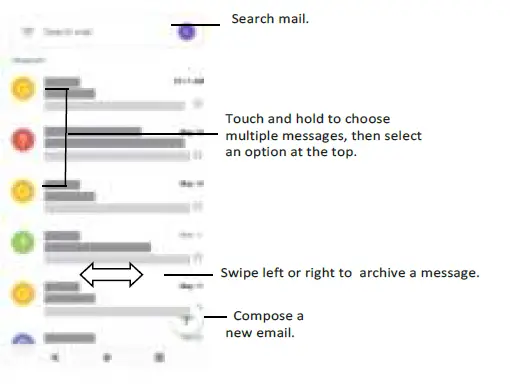
- Add Gmail accounts: The first time you turned on your phone, you probably set up or logged in to your Google account—that sets up the Gmail app for one account. To add more Google accounts, swipe up from bottom > Settings > Accounts, then tap Add account > Google.
Tip: In the Gmail app, tap > Settings > Add account. - Add email accounts: The Gmail app manages all of your email accounts. To add other personal email accounts to the Gmail app, swipe up from bottom > Settings > Accounts > Add account. For Microsoft® Exchange server work email accounts, tap Add account > Exchange, and enter details from your IT administrator.
- Change account settings: To change the settings for a Gmail or email account, swipe up from bottom > Gmail > > Settings, then tap the account name.
- Delete accounts: Swipe up from bottom > Settings > Accounts > Google, then tap the account name. Tap Menu > Remove account.
Duo
Sign in with your Google account to make and receive video calls.
Find it: Swipe up from bottom > Duo.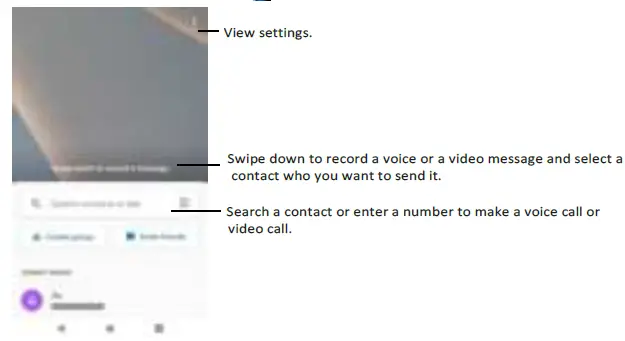
- Start a new video call: Tap a name in your contacts to start the video call.
- Preview incoming calls: See live video of the caller before you answer. To turn this off for both the caller and receiver, tap Menu > Settings > Knock Knock for this device.
- Change settings: Tap Menu > Settings to change the vibration setting, block numbers, and more.
- Call anyone: Duo works across platforms, allowing you to call friends with the Duo app on non-Android devices.
Tip: When on a video call, your phone will automatically switch from cellular network to Wi-Fi, if available
Calendar
See all your events, all in one place.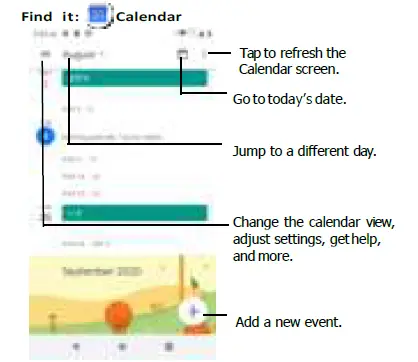
- Change the view: Tap the month at the top to choose a date to view. Or tap to choose Schedule, Day, 3 days, Week, or Month.
- Go to today’s date: Tap at the top.
- Add events: Tap > Event, enter event details, then tap Save.
Tip: Alternatively, tap a time on the calendar to enter event details. - Show, edit, or delete events: Tap an event to open it, then tap to edit it, or tap Menu > Delete to remove the event
- Show, hide, or add calendars: Tap and select which options, such as events,
Reminders, Holidays, to show or hide. You can use a computer to add or remove calendars on your Google account at www.google.com/calendar.
Tip: Add a Calendar widget to your home screen. Touch and hold an empty spot on the home screen, tap Widgets, then touch and hold Calendar and drag it to your home screen.
More apps
Google Play
Google Play is a digital content experience from Google where you can find and enjoy your favorite music, movies, TV shows, books, magazines, and Android apps and games.
- Download apps: Tap Play Store.
- Log in or open a Google account: Visit www.google.com/accounts.
- Google help: See www.google.com/support.
Contacts
Combine information from your Google contacts and social networks for quick access to everyone you know.
Tip: You can find most of these features on the Contacts tab in the Phone app. See Phone.
Find it: Swipe up from bottom > Contacts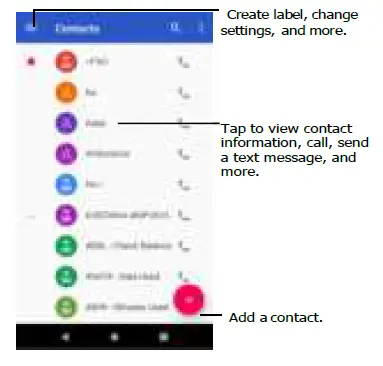
- Add a contact: Tap .
- edit or delete: Tap a contact, then tap or tap Menu > Delete.
- Call, text, or share: Tap a contact, then tap an option.
- Search contacts: In the Contacts list, tap .
- Share a contact: Tap a contact, then tap Menu > Share to send it in a message or email, via a Bluetooth connection, or save to Google Drive™.
Tip: Tap a contact, then tap Menu > Create shortcut to add a shortcut for the contact on your home screen. - Synchronize: On your phone, swipe up from bottom > Settings > Accounts, and choose your Google account. Then tap Account sync > Menu > Sync now. You can also see these contacts at www.gmail.com.
- Add your details: To store your user profile, tap > Settings >My info.
Favorites
Set your most-used contacts as favorites, so you can get to them faster.
- To set a favorite, swipe up from bottom > Contacts, select a contact and tap
- To see your favorites, tap Phone > .
Get contacts
Get all your contacts in one place.
- To add your social networking contacts, swipe up from bottom > Settings > Accounts, then tap Add account.
- To add your email contacts, see Gmail.
Tip: If you add an Exchange account, you can send messages to your coworkers, even if you don’t have them stored in your contacts. - To import contacts from .vcf file (if it didn’t happen automatically), swipe up from
Bottom > Contacts > Menu > Settings > Import > Import from .vcf file. - To import contacts from your computer, upload the contacts to your Google account at http://contacts.google.com. On your phone, swipe up from bottom > Contacts >Menu > Settings > Accounts > Automatically sync data. You can also see these contacts at http://mail.google.com.
Maps
Find a nearby cafe, get directions or step-by-step GPS voice navigation using Google
Maps™.
Find it: Swipe up from bottom > Maps.
Enter what you want to find in the search bar, or tap to search by voice.
Note: Your map screen may look different.
- Find an address: In the search field, enter an address or something you’re looking for, like “restaurant.” Tap a item to see more, or tap CALL or DIRECTIONS.
- Get directions: Tap Go, then enter a place or address.
- Zoom: To zoom in or out, drag two fingers together or apart on the screen.
- Turn and tilt: Rotate two fingers on the map to turn it, or drag up/down to tilt.
- Share a location: Tap a location, then tap the address and tap Menu > Share directions.
- Identify address: Touch and hold a spot on the map to show the nearest address.
- Get map help: Tap > Help.
For more on maps, visit support.google.com/maps.
Drive
Keep all your photos, videos, documents, and more safely in one place—private unless you choose to share. Available on Google DriveTM from all your devices.
Find it: Swipe up from bottom > Drive
- To create a new file or folder, tap .
- To open a file, tap it.
- Music, movies, TV & YouTube
Music
Music everywhere—stream it, buy it, save it, play it. Listen and create playlists anytime. Find it: Swipe up from bottom > YT Music. To upload your music library to Google Play Music, from a computer, visit www.google.com/music.
Listen to music online or listen to the music of SD card, swipe up from bottom > YT Music > Library > Songs, it will pop up “Play audio files from your device?”, then tap
Allow the musics of SD card will be showed on the DEVICE FILES.
Tip: Share songs directly with your contacts. Swipe up from bottom > Files, find the songs you want to share and select them, then tap to select a contact to share.
See Direct Share.
For more on the TY Music app, see support.google.com/music.
Note: Copyright—do you have the right? Always follow the rules. See “Content
Copyright” in the legal and safety information on your phone.
FM Radio
Find it: Swipe up from bottom > FM Radio Plug in a headset, then use the arrows to tune to a higher/lower frequency station.
Note: Your phone has the Frequency Modulation (FM) broadcast receiver functionality for reception without data usage. The phone will perform an auto tuning for the radio channels with the best signal.
YouTube™
Watch videos and podcasts from YouTube users everywhere—or log in to your account to share your own.
Find it: Swipe up from bottom > YouTube
Clock
Find it: Swipe up from bottom > Clock.
| Alarm | Tap . Tap an alarm to edit it, or tap to add a new alarm.
Tip: Pressing the volume button up or down while you’re setting an alarm sets the volume level for that alarm. When an alarm sounds, tap and drag to to turn it off, or drag to to snooze for ten minutes. |
| Clock | To change your alarm volume, snooze delay, or other settings, tap Menu > Settings. For other time zones, tap Home time zone. |
| Timer | For a timer, tap . |
| Stopwatch | For a stopwatch, tap . |
Tip: To set your current date, time, time zone, and formats, swipe up from bottom >Settings > System > Date & time.
Connect, share and sync
Connect accessories, computers, networks, and more.
Connect with Wi-Fi
Turn Wi-Fi power on/off
Find it: Swipe up from bottom > Settings > Network & internet > Wi-Fi, then tap the switch to turn it on. When Wi-Fi is on, your phone automatically reconnects to available networks it has connected before.
Note: You can also turn Wi-Fi on and off in Quick settings.
Connect to networks
To find networks in your range:
- Swipe up from bottom > Settings > Network & internet > Wi-Fi.
- With Wi-Fi turned on, tap a found network to connect to it. When connected, you’ll see in the status bar.
Note: If you see a question mark in the Wi-Fi status indicator , swipe the status bar down, tap CONNECT to connect the network, or tap the All NETWORKS to see all the network in range.
Wi-Fi hotspot
Your can make your phone a Wi-Fi hotspot to provide portable, convenient Internet access to other Wi-Fi enabled devices. Your phone turns off Wi-Fi and uses the mobile network for Internet access. Find it: Swipe up from bottom > Settings > Network & internet > Hotspot & tethering, then tap Mobile Hotspot.
Note: These steps may vary depending on your network.
Tap Mobile Hotspot to set up security:
- Hotspot name: Tap Hotspot name to rename your hotspot as you need.
- Security: Select the type of security you want: None or WPA2-Personal. For WPA2-Personal, tap Hotspot password to enter a unique password (8 characters) that others will need to access your Wi-Fi hotspot, tap OK to save the password.
Note: To protect your phone and hotspot from unauthorized access, set up hotspot security (WPA2 is the most secure), including a password.
Wi-Fi modes
Your phone supports the following Wi-Fi modes: 802.11 a, b, g, n.
Connect with Bluetooth wireless
Turn Bluetooth power on/off Find it: Swipe up from bottom > Settings > Connected devices > Connection preferences > Bluetooth, then tap the switch to turn it on.
Or Swipe up from bottom > Settings > Connected devices, tap the Pair new device the Bluetooth will be turned on automatically.
When Bluetooth is on, your phone automatically reconnects to available devices it has connected before. Turning Bluetooth on also lets other devices find your phone.
Note: You can also turn Bluetooth on and off in Quick settings.
Tip: To extend battery life or stop connections, turn the Bluetooth off when you do not use it.
Connect devices
The first time you connect a Bluetooth device, follow these steps:
- Make sure the device you are pairing with is in discoverable mode (for details, refer to the guide that came with the device).
- Swipe up from bottom > Settings > Connected devices > Connection preferences > Bluetooth.
- With Bluetooth turned on, tap a found device to connect it (if necessary, tap PAIR or enter a passkey like 0000). You can tap Devices name to rename the device and choose what the device will be used for.
When the device connects with other device, the name of the device be connected will be showed on the Bluetooth screen. When the device connects with bluetooth earphone, the Bluetooth connected indicator appears at the top of the screen. To automatically disconnect or reconnect a device, just turn the device off or on.
Note: Using a mobile device or accessory while driving may cause distraction and may be illegal. Always obey the laws and drive safely.
Transfer files
- Photos or videos: Open the photo or video, then tap > Bluetooth.
- Contacts: Swipe up from bottom > Contacts, tap a person, then tap Menu > Share >Bluetooth.
Share files with your computer
Note: Copyright—do you have the right? Always follow the rules. See “Content Copyright” in the legal and safety information on your phone.
USB
To load music, pictures, videos, documents, or other files from your computer, connect your phone to your computer with a USB cable. To change the type of USB connection, swipe the status bar down and tap USB.
Tip: Make sure to connect the phone to a high power USB port.
Note: The first time you use a USB connection, your computer may indicate that drivers are being installed. Follow any prompts you see to complete the installation. This may take a few minutes.
- For Microsoft® Windows®: On your computer, choose Start, then select Windows
Explorer from your list of programs. In Windows Explorer, your phone will appear as a connected drive (mass storage device) where you can drag and drop files, or it will appear as an MTP or PTP device that lets you use Windows Media Player to transfer
files. - For Apple™ Macintosh™: Use Android File Transfer, available at www.android.com/ filetransfer.
Virtual Private Network (VPN)
A VPN lets you access files on a secured network (like an office network with a firewall). Contact the network administrator for VPN settings, and any additional apps or requirements. To enter VPN settings, swipe up from bottom > Settings > Network & internet >Advanced >VPN. Tap to add a new VPN. Choose the type of VPN and enter settings
from the network administrator. Select the VPN name to connect.
Share your data connection
Your computer can access the Internet through your phone’s mobile network—you just need a USB cable.
- connect your phone to your computer using a USB cable.
Note: If your computer is running something older than Microsoft Windows 7 or Apple Macintosh OSX, it might require special configuration. - On your phone, swipe up from bottom > Settings, and make sure Wi-Fi is off.
- In Settings, tap Network & internet > Hotspot & tethering, then tap the USB tethering.
To stop the connection, tap USB tethering again, then disconnect your phone from your computer.
To print your photos, documents, and more from your phone, check if your printer’s manufacture has an app on Google Play. Then swipe up from bottom > Settings > Connected devices > connection preferences > Printing to get started. You can also send your photos, docs, and more to any Android device in your cloud or to Google Drive. Just download the Cloud Print app from Play Store.
Sync your Google account
When you log in to the same Google account, all devices can get to all the same apps, movies, books, and music from Google Play—plus you share the same Gmail, Google
Calendar™, and Google Mobile™. To add Google accounts to your phone, swipe up from bottom > Settings > Accounts > Add account > Google.
Phone & tablet
Your Android phone and tablet can work together to help you get the most out of both:
- Transfer media and files: Copy files to your phone and transfer them to other devices—see Transfer files.
- Phone hotspot: If you have a Wi-Fi tablet, turn your phone into a Wi-Fi hotspot to let your tablet access the Internet anywhere—see Wi-Fi hotspot.
- Bluetooth® accessories: If you have a Bluetooth keyboard or other accessories to use with your tablet, remember you can use them with your phone too. To connect them, see Connect with Bluetooth wireless.
Use a memory card
You can use your microSD card (sold separately) as portable or internal storage: - Portable storage (default): Store your pictures, videos, audio and other media files. You can remove the microSD card at any time and insert it in another device. The media files that are on the microSD card can be viewed and copied to that device.
- Internal storage: In addition to your media files, you can store some downloaded apps. The microSD card acts as an extension of the internal storage of your phone.
Note: Not all apps work from a microSD card.
To set your microSD card to internal storage, swipe up from bottom > Settings > Storage, then select the microSD card and tap Menu > Storage settings > Format as internal.
Caution: If your microSD card is set to internal storage, it is formatted and encrypted to protect your information. If you want to use it as portable storage, or in another device, you’ll need to reformat it. Before doing so, please remember that formatting erases all the data stored on your microSD card.
Note: Your phone supports a microSD card (sold separately). For best results, use a Class 10 (or higher) card. Mount or unmount memory card
To mount a microSD card, just put it in your phone (see Insert the SIM and microSD cards).
To unmount your microSD card (so you can take it out of your phone), swipe up from bottom > Settings > Storage. Then tap next to the microSD card name.
Caution: Do not remove a microSD card while your phone is using it or writing files to it.
Airplane mode
Use airplane mode to turn off all your wireless connections—useful when flying. Swipe the status bar down and tap Airplane mode .
Note: When you select airplane mode, all wireless services are disabled. You can then turn Wi-Fi and/or Bluetooth power back on, if permitted by your airline. Other wireless voice and data services (such as calls and text messages) remain off in airplane mode.
Emergency calls to your region’s emergency number still can be made.
Mobile network
You should not need to change any network settings. Contact your service provider for help.
To see network settings options, swipe up from bottom > Settings > Network & internet > Mobile network.
Protect your phone
Make sure your information is protected in case your phone is lost or stolen.
Screen lock
The easiest way to protect your phone is to lock your touchscreen when you are not using it. You can choose the best method for you to unlock your phone. Find it: Swipe up from bottom > Settings > Security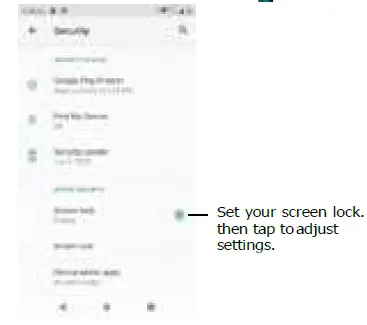
- Select the lock type:
- None: Turn off the screen lock.
- Swipe: Swipe up from bottom to unlock.
- Pattern: Draw a pattern to unlock.
- PIN: Enter four to sixteen digits to unlock.
- Password: Enter four to sixteen letters, digits, or symbols to unlock.
- After setting the lock type, tap for screen lock settings.
To change when your touchscreen goes to sleep, swipe up from bottom > Settings > Display > Advanced > Screen timeout.
Note: You can make emergency calls on a locked phone (see Emergency calls). A locked phone still rings, and you do not need to enter a PIN or password to answer acall.
Can’t unlock?
If you forget your pattern, PIN, or password, you can enter your Google™ account email and password on another device to unlock the phone.
If you don’t have a Google account on your phone, contact your service provider to
have your device factory reset.
Warning: A factory reset will delete all data on your phone.
Screen pinning
Need to keep an important screen handy, like a boarding pass or shopping coupon? Pin the screen for easy access. To set up screen pinning, swipe up from bottom > Settings > Security > Advanced > Screen pinning, then tap the switch to turn it on.
To pin a screen, open the app you want to pin, tap Recents . Touch and hold the app icon which you want to pin, then tap . To unpin the screen, touch and hold Back and Recents until you see Screen unpinned.
Tip: To secure your phone when you activate screen pinning, tap Ask for PIN before unpinning.
Backup & restore
Find it: Swipe up from bottom > Settings > System > Backup, then tap the Back up to Google Drive switch to turn it on/off. Your Google account data is backed up online. If you reset or replace your phone, just log in to your Google account to restore the contacts, events, and other details you synced with the account. To restore your Google Play apps, see Take care of your apps.
Encrypt your phone
Caution: If you forget your encryption code, you cannot recover the data stored on your phone or memory card. Encrypting your files can take an hour or more. Leave your phone plugged in, and be careful not to interrupt the process. Encryption protects the accounts, settings, apps, and files on your phone, so that people cannot access them if your phone is stolen. You shouldn’t need to use this feature, but to encrypt your phone and require a PIN or password whenever you turn on your phone, swipe up from bottom> Settings >
Security > Encryption & credentials > Encrypt phone.
Your privacy
Location
Some apps, such as Map, request your location in order to provide information, like directions or helping you find a nearby gas station.
- To turn location on or off: Swipe up from bottom > Settings > Location and tap Use location to turn on/off.
- To see which apps have access to your location, tap App permission.
Passwords
Your phone briefly shows password characters as you type. To turn this off, swipe up from bottom > Settings > Privacy and tap Show passwords.
App safety
Apps from Google Play
Get music, movies, books, apps, games, and more.
Find it: Play Store
Apps from the Internet
You can get apps from other online app stores using your browser.
Tip: Choose your apps and updates carefully, as some may impact your phone’s performance—see Choose carefully.
Note: When installing an app, make sure you read the alerts that tell you what information the app will access. If you don’t want the app to access this information, cancel the installation.
To let your phone install apps that are not on Google Play, swipe up from bottom > Settings > Apps & notifications > Advanced > Special app access, then tap Install Unknown apps and choose which sources are allowed.
Choose carefully
Here are a few tips:
- To help prevent spyware, phishing, or viruses, use apps from trusted sites, like the Google Play.
- Check the app’s ratings and comments before installing. If you doubt the safety of an app, don’t install it.
- Apps use up memory, data, battery, and processing power—some more than others.
If you’re not happy with how much memory, data, battery or processing power an app is using, uninstall it. - Monitor children’s access to apps to help prevent exposure to inappropriate content.
- Certain apps may not provide completely accurate information. Take care, especially when it comes to personal health.
Set app permissions
You may be asked for permissions when you use a feature in an app. To modify the app permissions settings, swipe up from bottom > Settings > Apps & notifications > Permission manager, then tap a feature (such as Camera) to see which apps have permissions to use it. Tap the switch to turn the permission on or off.
Take care of your apps
- Uninstall apps: To remove an app from a home screen page, touch and hold the app, then drag it to Remove. The app isn’t removed from your phone, just the home screen. To remove an app from your phone, touch and hold the app, then drag it to Uninstall.
Note: Not all apps can be uninstalled, but they can be disabled. - Disable/Stop apps: To disable an app or force it to stop running, swipe up from bottom > Settings > Apps & notifications. Tap an app, then tap DISABLE or FORCE STOP. To enable it, tap FORCE STOP.
- Reinstall apps: To reinstall apps from Google Play, swipe up from bottom > Play Store, then tap > My Apps & games > Library. The apps you downloaded are listed and available for download.
- See app details: Touch and hold an app, then tap .
- See app data usage: To show which apps are using the most data, swipe up from bottom > Settings > Network & internet > Mobile network > Data usage. For more, see Data usage.
Data usage
You can track the amount of data your phone uploads and downloads.
Find it: Swipe up from bottom > Settings > Network & internet > Mobile network > Data usage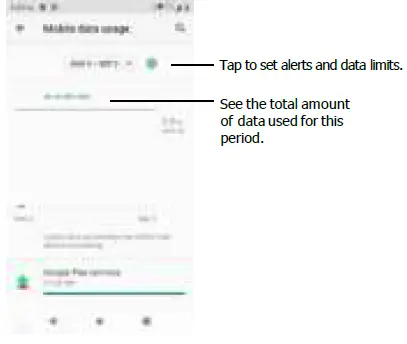
Some apps transfer data in the background when you’re not viewing them—to help reduce this type of data usage, Swipe up from bottom > Settings > Network & internet > tap Data saver to turn it on.
Note: Usage information is provided to help you manage your phone. This may not match the amounts charged by your service provider, as they’re not measured in the same way.
Troubleshoot your phone
Restart or remove an app
If an app locks up your phone as soon as you turn it on, restart in Safe Mode: Press and hold the Power button. When you see the Power off option, press and hold it. Your phone restarts with Safe mode in the lower left. Then, try removing the app. To exit safe mode, restart your phone.
Restart your phone
In the unlikely event that your phone stops responding to touch and press button, try a reboot—press and hold the Power button until the screen goes dark and your phone restarts.
Check for software update
To manually check for updates, swipe up from bottom > Settings > System >
System update.
Your phone downloads updates over your Wi-Fi connection (if available) or mobile network. We recommend that you download updates over a Wi-Fi connection. Theseupdates can be quite large and may not be available in all countries.
Note: When updating your phone, make sure you have enough battery power to complete the update.
Reset
To reset your phone to factory settings and erase all the data on your phone, swipe up from bottom > Settings > System > Reset options > Erase all data (factory reset). Warning: All downloaded apps and user data on your phone will be deleted. Data on the cloud will not be deleted.
Stolen phone
Your phone has Android Device Manager. You can remotely lock or reset your device to protect your device from thieves. For details, see www.google.com/android/ devicemanager.
Find the IMEI number
You can find the IMEI number by typing *#06# on your phone’s dialpad. Or swipe up from bottom > Settings > About phone > IMEI.
Note: For service and support, see Get more help.
Accessibility
See, hear, speak, feel, and use. Accessibility features are there for everyone, helping to make things easier.
Find it: Swipe up from bottom > Settings > Accessibility
Create a shortcut
Use a gesture to quickly activate an accessibility features on your phone. For more information, swipe up from bottom > Settings > Accessibility > Volume key shortcut. Tap Shortcut service and choose an app. When the shortcut is on, press both volume buttons for three seconds to start the app.
Make your phone speak
Select to speak
Find it: Swipe up from bottom > Settings > Accessibility > Select to Speak Turn on, then tap and press . Your phone reads the screen from top to bottom.
Tap Read in background to turn it on, Speak will continue reading when you move to other screens or apps. Tap Read text on images to turn it on, Tap on text within photos or the Camera viewfinder to hear the text read aloud.
TalkBack
Use TalkBack to read your screen out loud—screen navigation, selections, even books.
To turn TalkBack on or off, swipe up from bottom > Settings > Accessibility >
TalkBack.
- Tap something on the screen to hear a description or text readout.
- Double-tap anywhere on the screen to open or activate the last touched item.
- Swipe using two fingers to scroll through lists or between screens.
Text-to-speech output
To set the language, speech rate and pitch of the screen reader, swipe up from bottom > Settings > Accessibility > Text-to-speech output.
Braille
Combine your Braille display with TalkBack for braille and speech feedback.
- Download the BrailleBack™ app on Google Play (swipe up from bottom > Play Store), and install it on your phone.
- Swipe up from bottom > Settings > Accessibility > BrailleBack.
- Turn on your Braille display and put it in Bluetooth pairing mode.
- On your phone, swipe up from bottom > Settings > Bluetooth, then tap the switch at the top to turn it on and scan.
- Tap the name of your Braille display to pair it with the phone.
Speak to your phone
Speak a command to turn on an accessibility feature. For example: “Ok, Google, turn on TalkBack”. For more on voice commands, see Speak.
Change your phone’s display
Display settings & magnification
Get a closer look.
- Change font size: Increase the font size on your screen. Swipe up from bottom > Settings > Accessibility > Font size. See also Customize sounds & appearance.
- Change display size: Make the items on the screen larger. Swipe up from bottom > Settings > Accessibility > Display size.
- Pinch to zoom: Pinch to zoom on maps, and photos—to zoom in, tap the screen with two fingers and then drag them apart. To zoom out, drag your fingers together. You can also double-tap to zoom in.
- Screen magnification: Triple-tap the screen for full screen magnification, or tripletap and hold to temporarily magnify. Swipe up from bottom > Settings >Accessibility > Magnification.
- Display brightness: Swipe the status bar down, and drag the slider to set brightness level. Setting brightness to a high level decreases your phone’s battery life.
- Browser: Choose text size when browsing websites. Swipe up from bottom> Chrome > Menu > Settings > Accessibility. Select Force enable zoom to allow zooming on all web pages.
Messages
To make text entry even easier, use features like auto-capitalization, auto-correction, and more. Swipe up from bottom > Settings > System > Languages & input > Virtual keyboard > Gboard > Text correction. Or speak your message. Tap on the keyboard.
Change your phone’s sounds
Calls
When you want to hear who’s calling, assign a unique ringtone to a contact. Swipe upfrom bottom > Contacts, tap the contact, then tap Menu > Set ringtone. To end a call by pressing the Power button, swipe up from bottom > Settings > Accessibility and tap Power button ends call.
Volume & vibrate
Find it: Swipe up from bottom > Settings > Sound
- Drag the volume sliders to set volume levels for your music or videos, alarms, and ringtones/notifications.
- To make your phone vibrate for incoming calls (even when the ringer is silent), tap Vibrate for calls.
Tip: Feel a vibration when you tap the screen. Tap Advanced > Touch vibration to turn it on.
Hearing aids (U.S. only)
To help to get a clear sound when using a hearing aid or cochlear implant, your phone may have been rated for use with hearing aids. If your phone’s box has “Rated for Hearing Aids” printed on it, then please read the following guidance.
You may also want to consult your hearing health professional, who should be able to help you get the best results.
- Settings: Tap Phone > Menu > Settings > Accessibility > Hearing aids.
- Call volume: During a call, press the side volume buttons to set a call volume that works for you.
- Position: During a call, hold the phone to your ear as normal, and then rotate/move it to get the best position for speaking and listening.

Get more help
Get answers, updates, and info:
- Get more: Get software, FAQs, and more at https://kazuna.co.jp/support/.
- Join the conversation: Find us on YouTube, Facebook™, and Twitter.
Where is my legal, safety, & regulatory information?
In order to provide you with better access to this important information, we’ve made the materials accessible from the phone’s settings menu and on the web. Review these materials prior to using your device. To access the materials from a connected phone, go to Settings > System > Legal information, and select a topic.
Service & repairs
If you have questions or need assistance, we’re here to help. Go tO https://kazuna.co.jp/support/, where you can select from a number of customer care options. Get more help
Phonecurious.com
How do I add HE detergent, fabric softener, and/or bleach?
It is important to use only HE (High Efficiency) detergents. See the ADDING LAUNDRY PRODUCTS section in your Owner’s Manual for more information.
ADDING LAUNDRY PRODUCTS IMPORTANT: Using non-HE (High Efficiency) detergents or fabric softeners can result in poor washing performance and/or fabric damage.
STEP 1. ADD HE DETERGENT Designed to use only HE (High Efficiency)detergents.
STEP 2. ADD FABRIC SOFTENER AND/OR BLEACH
STEP 3. PRESS START TO BEGIN CYCLE
NOTE: Start button must be held for 1 second to start cycle. Once the status lights are illuminated, release the start button.
ADDING LAUNDRY PRODUCTS IMPORTANT: Using non-HE (High Efficiency) detergents or fabric softeners can result in poor washing performance and/or fabric damage. STEP 1. ADD HE DETERGENT (See ADDING LAUNDRY PRODUCTS section in your Owner’s Manual for more information.) STEP 2. ADD FABRIC SOFTENER AND/OR BLEACH (See ADDING LAUNDRY PRODUCTS section in your Owner’s Manual for more information.) STEP 3. PRESS START TO BEGIN CYCLE NOTE: Start button must be held for 1 second to start cycle. Once the status lights are illuminated, release the start button. ADDING LAUNDRY PRODUCTS (See ADDING LAUNDRY PRODUCTS section in your Owner’s Manual for more information.) A: It is important to use only HE (High Efficiency) detergents. See the ADDING LAUNDRY PRODUCTS section in your Owner’s Manual for more information.
FAQS
Who makes the Kazuna eTalk phone?
Verizon Kazuna eTalk is one of the options for a basic phone on the market today.
When did the eTalk Myflix come out?
The Kazuna eTalk MyFlix smartphone was released in September 2020. It is marketed as a low-cost phone. With its affordable price, it’s safe to expect the specs would be low too. We’re not wrong, as it turns out.
What is the 3 digit number to activate a Verizon phone?
described under Setting Up Your Phone (page 5 ). Option 3 – Over the Air Activation You can call us to activate your phone. Step 1. From another phone, dial 866.893.7723 and follow the prompts to start activating your phone.
Does the Kazuna eTalk have Bluetooth?
Your Kazuna eTalk™ is visible to other devices as long as the Bluetooth® settings screen is open and Bluetooth is turned on.
Why did Verizon send me a new flip phone?
Verizon is sending free 4G flip phones to customers who are still using the company’s older 3G network, which it plans to retire by the end of 2022, according to the company’s support page. Verizon’s issuing the devices to people who haven’t yet upgraded to a 4G LTE phone.
Does an eTalk phone have a SIM card?
From the notch (located on the bottom corner), gently lift and remove the battery cover. Insert the SIM card into the SIM slot with the gold contacts facing down.
Is Verizon giving away free flip phones?
But the carrier is still contending with a subset of customers who sat out the 4G LTE era and haven’t yet upgraded their 3G phones. So, as 2022 rolls onward, Verizon is sending those wireless subscribers a free extremely basic flip phone to prevent them from losing connectivity when the 3G network goes offline.
What does it mean when a phone is prepaid?
A Prepaid mobile service is one that you pay for upfront when you purchase a SIM Starter Kit or a recharge. You pay a certain amount of money before you start using the service, which is converted into mobile credit used for: Making calls. Sending text messages.
Where is the SIM card in a Verizon flip phone?
Remove the battery cover. Insert your fingernail (or a similar tool) into the cutout located on the lower-right corner of the battery cover to lift and remove the cover. In the top left of the battery compartment, slide the SIM card into the SIM tray with the gold contacts facing down.
Can a prepaid phone be tracked?
Prepaid phones can also be tracked using the traditional, albeit less-accurate, method of cellular triangulation. However, even with such features enabled, locating a prepaid phone’s user remains difficult. Even the NSA has issues immediately locating and identifying prepaid burner users.
Do prepaid phones have Internet?
Limited features — You probably won’t find the latest, most sophisticated features on the average cheap prepaid cell phone. It probably won’t be a picture phone. It also won’t have Internet access or the ability to share videos. However, some companies are offering more high-tech phones.
Do prepaid phones expire?
Yes and no. As long as you continue to make payments, your prepaid number should not expire. Even if you miss a payment, most major carriers should offer a grace period. During this time, you still have the option to make the full payment due for your prepaid plan while keeping your phone number active.
Is prepaid better than a plan?
So, the strict difference between prepaid vs. postpaid plans is when you pay your bill. But it’s generally true that prepaid plans are cheaper and offer more flexibility, while postpaid plans are more expensive and offer more perks.
Why is prepaid cheaper than plan?
Prepaid phone plans let you pay your monthly bill before the start of each monthly billing cycle, rather than paying at the end like postpaid. They don’t require a credit check or contract, as you only use the voice, text, and data services you’ve paid for ahead of time.
Is Verizon prepaid plans worth it?
Verizon prepaid plans are a great deal for those who want more affordable service on the nation’s best network. But, there’s a catch (or two). If you like to set up a mobile hotspot so you can work or be entertained while you’re out and about, then Verizon’s prepaid plans are not the best.
What is Verizon offering for free?
Verizon followed in its competitors’ footsteps today and announced that its customers can trade in an old phone and get a new 5G phone for free, with select plans. For existing customers, Verizon will offer up to $700 for a new iPhone or $800 for a new Andro
What’s the difference between SIM only and prepaid?
SIM-only mobile plans are a form of postpaid mobile plans. The big difference is, like prepaid, you need to bring your own handset, but you’re still paying a monthly bill after the fact.
How does a SIM-only plan work?
A SIM-only plan is a phone plan that is just the SIM – not the phone. You get a certain amount of calls, minutes and data and it’s cheaper because you’re not paying for a handset. By putting the SIM into a phone you already own you save money – and the planet.

